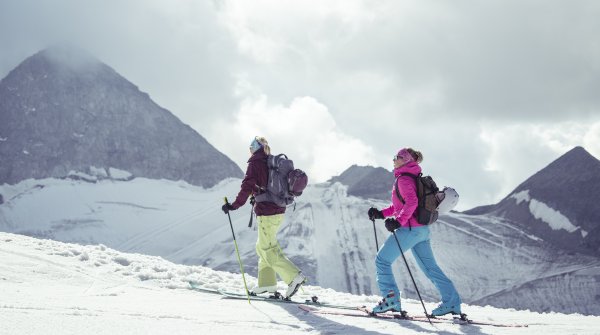
If you want equality in sport, you have to question and reflect on social structures. First and foremost, our treatment of the female body. Because the relationship to the female body is a culturally and socially shaped one. Don't worry: The relationship to the male body is too -but this article is about girls and women and facilitating access to sports. From a young age, girls get different cultural messages about what it really means to be a woman. And therefore also: a sportswoman. It's not always necessarily about the body at all, but also the behavior of young girls. Who doesn't remember the saying "You throw like a girl." What seems funny at first glance also suggests: girls can't throw properly. But is that really true? Let's ask discus thrower Nadine Müller. She will surely prove us wrong. Nonetheless, such slogans define how girls and women see themselves. What they (can) believe in themselves.
It's a fine line between socially desirable and standardized femininity, because the phrase "Don't act like a little girl", which many an athlete throws at himself, is never a joke or even a compliment.
And yet, these sayings make sure to put the brakes on girls. Braking them from playing a sport that has a masculine connotation. They'd rather take up ballet or swimming or tennis. No question, all great sports, and yet there are certainly a bunch of young women out there who would find their greatest joy in breaking gender barriers and breaking societal stereotypes. That's when they take part in a sport that's really reserved for boys, that they not only thrive in, but are good at. One example here is 13-year-old Sky Brown, who is competing in the Tokyo Olympics for the first time this year. In the discipline of skateboarding. An important step. Not just for Sky Brown, but for all girls who also dream of the skateboarding life.
"Surely girls can play any sport they want?" it surely shouts from somewhere. In theory yes, in practice - well. For all those who claim the gender debate is water under the bridge, here's some statistics. all those who claim this debate is water under the bridge, now some statistics. Figures from the Women's Sports Foundation (USA) show that girls are generally underrepresented in sports, start later and stop earlier. Especially in big cities or among young girls and women from visually identifiable minorities, this imbalance can be observed more often compared to boys. However, this is not - as might be assumed at first glance - due to girls either. According to the surveys, the young women definitely enjoy showing ambition, being - –also with boys - –and developing a feeling for their bodies. However, sport as a space of experience is male dominated and - in the media women's sport is underrepresented. Finding role models is more difficult. In addition, young girls face additional challenges compared to their male peers if they want to be active in sports on a long-term basis. For this reason, girls often do not take advantage of sporting opportunities to the extent that they could.
Yet sport offers enormous social potential, especially for challenging and encouraging girls. Sport also prevents depression and anxiety, diseases which, according to the WHO, are on the rise among younger people in urban areas. Sporting goods manufacturers are also already aware of this potential. For example Nike, for example, has developed a guide specifically for coaching girls, fitness watch manufacturers and Garmin with "Being Brave in a Big World" a book of adventure stories by female athletesof female athletes in order to bring girls closer to role models in a playful way.

Some biases and stereotypes are deeply rooted and, although adults want the best for young girls, often hinder their athletic development. According to experts, our society tends to raise boys to be brave, while girls are raised to be perfect. This is not just true in sports, but applies to all walks of life, as Reshma Saujani points out in her TED Talk explains. Paraphrased to sports, it can look like this: While girls are celebrated, praised and rewarded just as much when they get something right, it's a different story when they try a technique or a more difficult trick, something new or risky that they don't immediately succeed at.
So the ball is in our court as adults. So what can we do to ensure that girls and young women take their place in sport?
First, we should probably become aware of our own internalized biases and try to challenge and redefine them, whether as parents or coaches. Using a slide bar on the playground, researchers found that girls were more likely to be warned by their parents that they could get hurt or helped if they wanted to play there anyway. And little boys? They were encouraged to do so, even though they might have been scared, and given assistance so they could play on their own, using the slide pole themselves. Here lies the potential to reflect and transform one's own behaviour and acquired ways of thinking.

Ironically, until puberty, boys and girls are very similar in terms of basic physical requirements. Sometimes girls are even further along and more mature at a young age. This also speaks for mixed teams and teams.
The problem: kids soak up adult messages. If, we act like girls are more fragile, can endure less, need more help and so on, kids adopt these ways of thinking. The next time they hear "Watch out, you're going to hurt yourself", "Don't do that, it's dangerous" or "You won't be able to do that anyway, so you'd better not", they should be aware of the hidden message they're sending, namely that the girl shouldn't try, that she's not good enough in the first place and that she should actually be scared. At the same time, the family plays a big role in the sporting career of young girls: If she is involved in the club or is particularly convinced and enthusiastic about an individual sport, girls are more likely to stick with it.
Fear is important, it protects us. However, it is just as important for young girls as it is for boys to learn how to deal with risks and dangers, to endure stress and tension, and to gain self-confidence because they know better how to assess themselves and their own abilities. For girls, the pressure is often particularly high to be perfect, to present themselves in a positive light. Social media is an important factor in this, influencing girls' self-assessment in comparison to others. This can be the reason why girls are less likely to try something new that they are not sure will be successful. Trainers should therefore give girls the confidence to take risks in order to learn something new. Failure is also part of the process if you want to get better. Courage should be prioritized and trying new things should be given as much or even more positive attention as good performance.

At the same time, we should also look at our own noses. Role models with whom children identify make a goal seem even more attainable and desirable. However, structural inequalities continue to be a problem. Many coaching positions, especially in male-dominated sports, are - –naturally - also male. Many girls are trained by male trainers and coaches, but very few boys are trained by women. If you take football as an example, this runs through from grassroots sports to professional leagues. And such tendencies can also be seen in sports like skateboarding, snowboarding or skiing.
While male coaches should by no means be denied their voluntary commitment, it is nevertheless a structural problem. Because this also suggests to children, both consciously and unconsciously, that certain positions in sport cannot be performed equally by men and women, or that women are not present.

There is room for improvement here for all of us: on the one hand, for women to have the courage to take the risk of applying for office, even if not everything goes perfectly or there is a 100% chance of success. At the same time, equal access conditions should be created for everyone in sport.
In the same way, there is a need for female role models for girls who show that they can dare, that they are allowed to fail, so that they can continue and stick to sport anyway. It helps, for example, when female coaches share stories in which they failed, but perhaps learned from it after umpteen attempts to stand a trick or to climb with a certain move through a difficult route, which may be solved differently under different physical conditions. This shows that even adult role models are not perfect, but that courage and perseverance still pay off.
It is important that young girls and women find role models more and more often. And that brings us back to the beginning of this article: Things are already happening. Role models are becoming more common, women are taking media exposure more often, and social media is making it easier for female athletes to get in the spotlight. Young women are increasingly getting a glimpse of the possibilities that sport can open up if they follow untrodden paths. That being said, we as an industry shouldn't stop keeping our eye out for girls on adventures too- –and outdoor sports to make it truly accessible to all who want it. Because it is:
An opportunity to feel free, self-actualize and grow. And a school for the rest of life, to learn and take with you. Something that should be open to boys and girls.
 Transformation6 megatrends transforming the sports industry
Transformation6 megatrends transforming the sports industry TransformationHow sports communities influence one's performance
TransformationHow sports communities influence one's performance
- Awards
- Mountain sports
- Bike
- Fitness
- Health
- ISPO Munich
- Running
- Brands
- Sustainability
- Olympia
- OutDoor
- Promotion
- Sports Business
- Textrends
- Triathlon
- Water sports
- Winter sports
- eSports
- SportsTech
- OutDoor by ISPO
- Heroes
- Transformation
- Sport Fashion
- Urban Culture
- Challenges of a CEO
- Trade fairs
- Sports
- Find the Balance
- Product reviews
- Newsletter Exclusive Area
- Magazine



